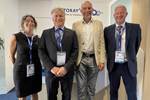DLR HAP-alpha solar aircraft demonstrator passes key ground tests
The CFRP uncrewed aircraft platform, designed as a sustainable alternative to satellites, completed ground vibration testing, leading up to flight trials in 2026.
The plan is for HAP-alpha to gradually reach an altitude of up to 20 kilometers. Source (All Images) | DLR (CC BY-NC-ND 3.0)
The German Aerospace Center – DLR (Cologne) announces that its high-altitude solar aircraft, HAP-alpha, has completed ground vibration testing (GVT), a key milestone in flight readiness, at its National Experimental Test Center in Cochstedt. Further tests will follow and the first low-altitude flight trial is planned for 2026, subject to ideal weather conditions.
HAP-alpha is highly elastic, solar-powered uncrewed aircraft platform designed to operate in Earth’s lower stratosphere for extended periods, performing a wide range of observation and communications tasks from monitoring shipping lanes and supporting disaster response to providing internet access. The structure, weighing only 138 kilograms and with a 27-meter wingspan, is made entirely of carbon fiber-reinforced polymer (CFRP) — specifically, the DLR uses wound round CFRP spars and ribs made from a CFRP sandwich material.
“With HAP-alpha, DLR is demonstrating its comprehensive systems expertise in the complete design, development and operation of a new and innovative aircraft, incorporating all disciplines,” explains DLR executive board member for aeronautics, Markus Fischer. “This illustrates our engagement in an important field of innovation, to strengthen Germany as a location for technology and business and to open up new perspectives for our public stakeholders in collaboration and knowledge exchange.”
A particular challenge of the GVT was the HAP-alpha’s lightweight and therefore highly flexible design. HAP-alpha’s wings are not yet covered for the tests, so the supporting structures are visible in this image. Source |
The now completed GVT is an important milestone for investigating the vibration behavior of an aircraft. The goal is to identify critical vibrations that can occur during flight, takeoff and landing. This determines whether an aircraft is safe and thus airworthy. For HAP-alpha, the successful GVT marks a key step on the way to first flight tests next year, which will involve basic flight maneuvers at low altitude.
During the GVT, numerous sensors were used to record the dynamic properties of the platform, which was fitted with electromechanical vibrators so that its vibration characteristics could be identified. A particular challenge of the GVT on HAP-alpha was its very lightweight and therefore very flexible design.
The acquired data will now be used to update simulation models and predict flight behavior even more precisely, especially during maneuvers, turbulence and gusts of wind. “This allows the project team to focus on the upcoming complete system tests, which will mark the completion of ground testing and enable subsequent flight testing,” says HAP project leader Florian Nikodem from the DLR Institute of Flight Systems.
Related Content
Infinite Composites: Type V tanks for space, hydrogen, automotive and more
After a decade of proving its linerless, weight-saving composite tanks with NASA and more than 30 aerospace companies, this CryoSphere pioneer is scaling for growth in commercial space and sustainable transportation on Earth.
Read MorePlant tour: Collins Aerospace, Riverside, Calif., U.S. and Almere, Netherlands
Composite Tier 1’s long history, acquisition of stamped parts pioneer Dutch Thermoplastic Components, advances roadmap for growth in thermoplastic composite parts.
Read MoreOtto Aviation launches Phantom 3500 business jet with all-composite airframe from Leonardo
Promising 60% less fuel burn and 90% less emissions using SAF, the super-laminar flow design with windowless fuselage will be built using RTM in Florida facility with certification slated for 2030.
Read MoreCombining multifunctional thermoplastic composites, additive manufacturing for next-gen airframe structures
The DOMMINIO project combines AFP with 3D printed gyroid cores, embedded SHM sensors and smart materials for induction-driven disassembly of parts at end of life.
Read MoreRead Next
Toray Advanced Composites to supply composites for constellation solar arrays
Per a long-term agreement, space-qualified carbon fiber/epoxy materials will be delivered to Airborne for high-volume production of solar array substrates and yoke panels.
Read MoreRock West sandwich panels support high-power Astro Digital satellites
RWC built and delivered solar array substrate panels from trace/lead-integrated skins that enable direct integration with solar cells, saving weight and time.
Read MoreScaling up, optimizing the flax fiber composite camper
Greenlander’s Sherpa RV cab, which is largely constructed from flax fiber/bio-epoxy sandwich panels, nears commercial production readiness and next-generation scale-up.
Read More












